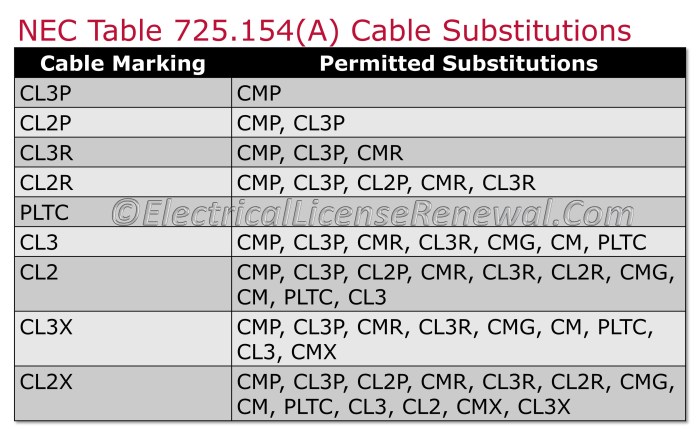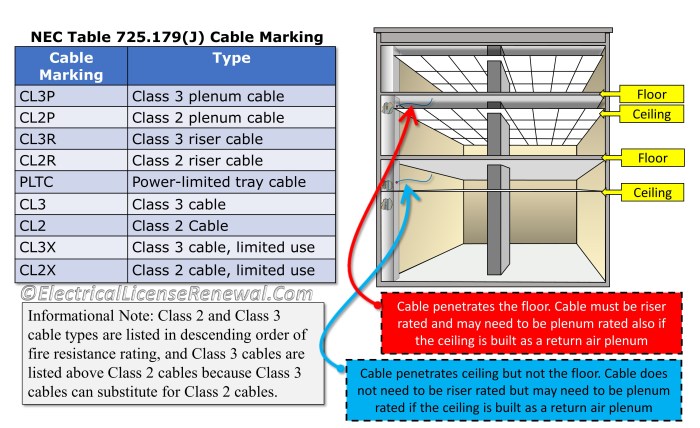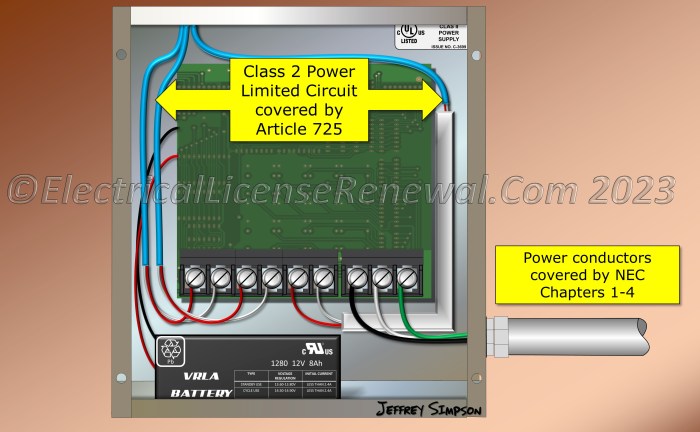Low voltage system wiring is covered in what nec article – In the realm of electrical wiring, low voltage systems hold a significant place. To ensure the safety and efficacy of these systems, the National Electrical Code (NEC) provides comprehensive guidelines in Article 725. This article serves as a cornerstone for understanding the requirements and best practices associated with low voltage system wiring.
Delving into the NEC, we will explore the scope and purpose of Article 725, examining the types of low voltage systems it encompasses. Furthermore, we will delve into the various wiring methods permitted for these systems, weighing their advantages and disadvantages.
Safety considerations will be paramount, as we identify potential hazards and discuss the measures necessary to mitigate risks.
National Electrical Code (NEC) Overview: Low Voltage System Wiring Is Covered In What Nec Article

The National Electrical Code (NEC) is a comprehensive set of regulations that govern the design, installation, and maintenance of electrical systems in the United States. It is published by the National Fire Protection Association (NFPA) and is updated every three years to reflect changes in technology and industry practices.
The NEC is intended to ensure the safety of electrical systems by providing minimum requirements for the installation and maintenance of electrical equipment and materials. It is widely adopted by state and local governments as the basis for electrical codes, and it is also used as a reference by electrical engineers, contractors, and inspectors.
History and Development of the NEC
The first edition of the NEC was published in 1897 by the National Board of Fire Underwriters (NBFU). The NBFU was a trade association of fire insurance companies that was formed in 1866 to reduce the number of fires in the United States.
The first edition of the NEC contained only 70 pages of regulations. Over the years, the NEC has grown in size and scope to address the increasing complexity of electrical systems.
Different Sections and Articles within the NEC
The NEC is divided into nine sections, each of which covers a different aspect of electrical systems.
- Article 1: General Requirements
- Article 2: Wiring and Protection
- Article 3: Equipment for General Use
- Article 4: Equipment for Special Occupancies
- Article 5: Special Equipment
- Article 6: Special Conditions
- Article 7: Special Communications Systems
- Article 8: Signaling Systems
- Article 9: Tables and Examples
Low Voltage System Wiring in NEC

Scope and Purpose of Article 725
Article 725 of the NEC covers the installation of low voltage systems. Low voltage systems are defined as systems that operate at less than 50 volts. These systems are typically used for control, signaling, and communication purposes.
Article 725 provides requirements for the installation of low voltage wiring, including the types of wiring that can be used, the methods of installation, and the safety precautions that must be taken.
Requirements for Low Voltage System Wiring, Low voltage system wiring is covered in what nec article
The requirements for low voltage system wiring are less stringent than the requirements for high voltage wiring. This is because low voltage systems are less likely to cause fires or electric shock.
However, there are still some important requirements that must be followed when installing low voltage systems. These requirements include:
- The wiring must be installed in a neat and workmanlike manner.
- The wiring must be protected from physical damage.
- The wiring must be properly grounded.
FAQ Corner
What types of low voltage systems are covered in Article 725 of the NEC?
Article 725 covers a wide range of low voltage systems, including power-limited circuits, remote-control and signaling circuits, and fire alarm systems.
What are the key safety considerations for low voltage system wiring?
Proper grounding, bonding, and overcurrent protection are crucial safety measures for low voltage system wiring. These precautions help prevent electrical shocks, fires, and other hazards.
What are the different wiring methods permitted for low voltage systems?
Conduit, cable trays, and raceways are among the approved wiring methods for low voltage systems. The choice of method depends on factors such as the environment, voltage level, and system requirements.

